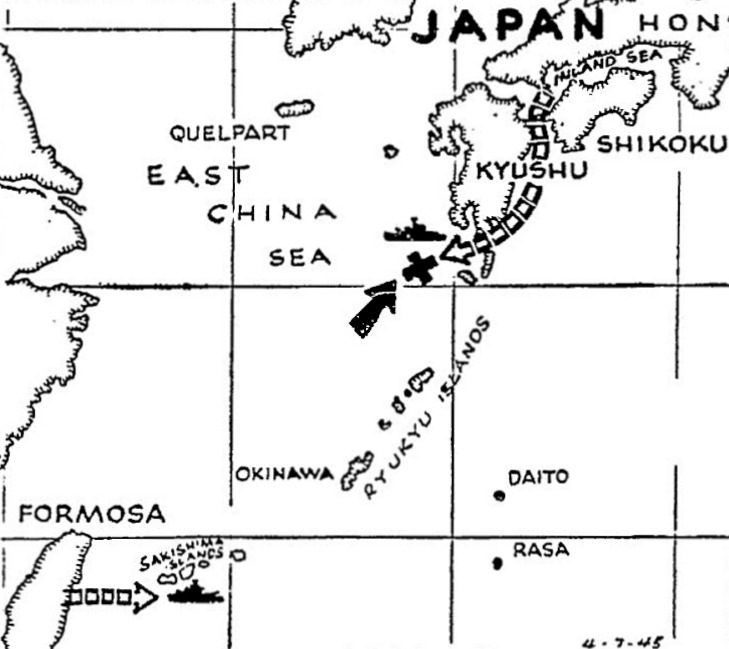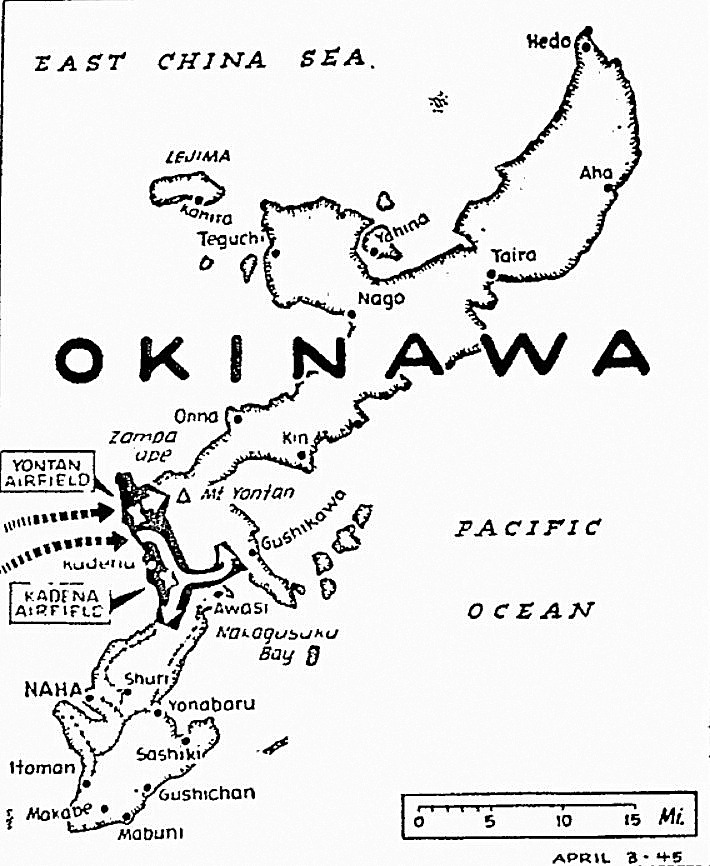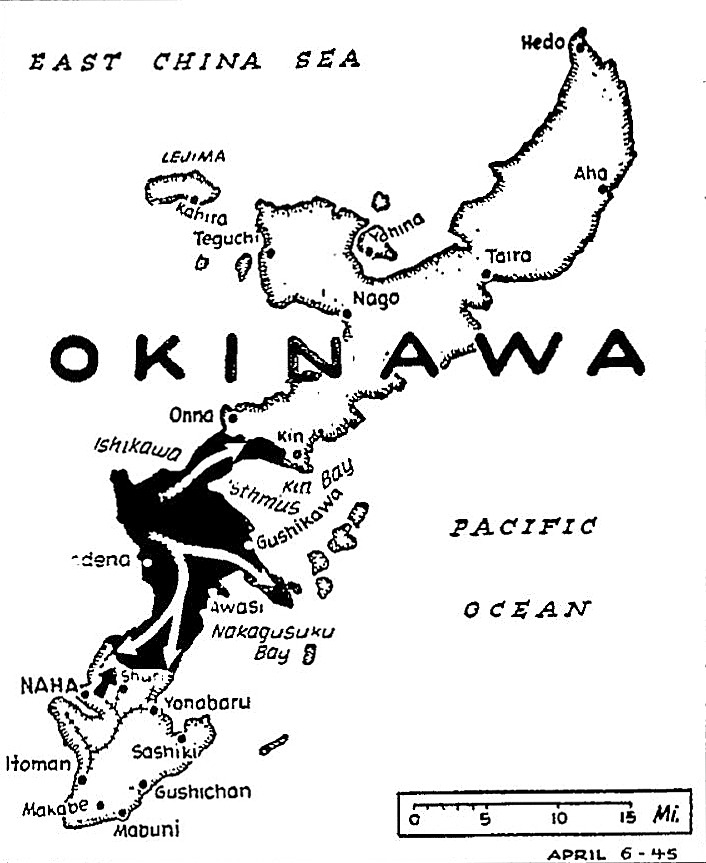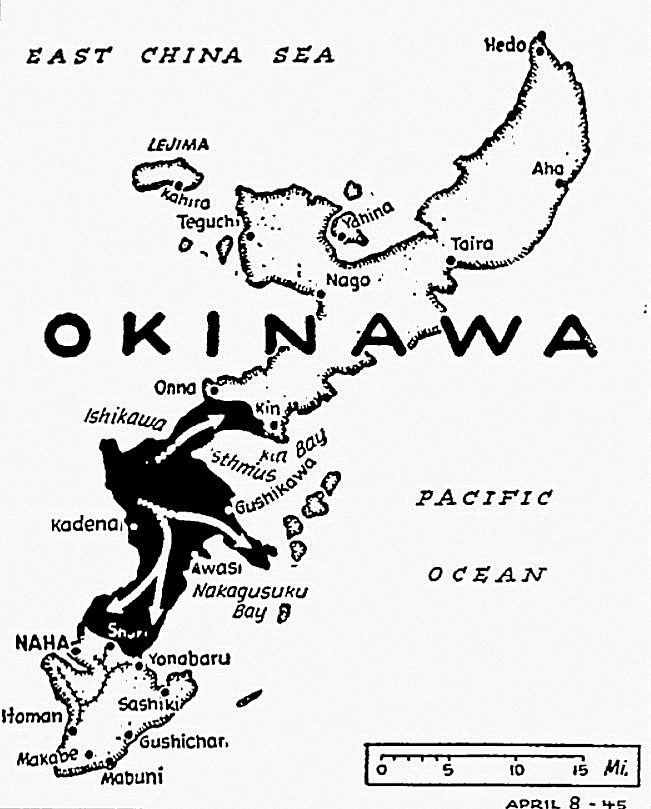The Pittsburgh Press (April 7, 1945)
8 other war vessels blasted by Mitscher – 391 planes destroyed

Jap fleet blasted north of Okinawa
GUAM (UP) – Adm. Chester W. Nimitz today announced Japan had lost the most powerful dreadnaught left in her battered fleet – the 40,000-ton super-battleship Yamato – eight other warships sunk or damaged and 391 planes in a desperate air and sea attempt to stem the American invasion of Okinawa.
U.S. losses were three destroyers sunk, several destroyers and smaller craft damaged, and seven planes shot down.
In addition to the Yamato, the Japs lost a light cruiser of the 6,000-ton Agano class, a smaller cruiser and three destroyers. Three other destroyers were left burning.
Their air losses included: 116 planes lost to U.S. fighters and anti-aircraft in a Jap attack April 6 on shore installations and ships off Okinawa; 245 planes shot down by fleet carrier fighters in the same action; 30 Jap planes shot down April 7, the day on which the Jap fleet losses were inflicted.
The Yamato was hit by at least eight torpedoes launched by torpedo aircraft, and eight heavy bombs, in addition to strafing by rocket and machine-gun fire.
Adm. Nimitz revealed that the blow to the desperate Japs was once again inflicted by the fast carrier force of Vice Adm. Marc A. Mitscher.
The Yamato, Adm. Nimitz said, was the most powerful battleship left in the Jap fleet. It was probably Japan’s newest dreadnaught, laid down in 1938 or 1939, and probably commissioned after the start of the Pacific war.
It was rated at better than 40,000 tons but the exact figure never was known. It was supposed to have been armed with nine 16-inch guns and had a speed of 30 knots or better.
The Okinawa sea-air battle, Adm. Nimitz revealed, opened yesterday, Guam Time, with a strong Jap air attack launched against our forces on Okinawa and the concentration of ships lying off shore.
The Japs “pressed their attacks with desperation,” Adm. Nimitz said, and succeeded in sinking three U.S. destroyers and damaging several other smaller craft. But they failed to hit any of our larger fleet units.
In this battle the fleet carrier fighters had a field day, knocking 245 Jap planes out of the sky while fighter plane pilots on Okinawa and ack-ack batteries there accounted for another 116.
Early today fleet air search planes sighted a Jap surface fleet which had steamed out of its refuge in the Inland Sea and, passing south of the Jap island of Kyushu, had headed into the East China Sea.
The force, possible as strong a fleet as the Japs could muster for their all-out effort to oust us from Okinawa, was seen to comprise the Yamato, one Agano-class light cruiser, another smaller light cruiser. or large destroyer and an unspecified number of other destroyers.
Adm. Mitscher, as so many times previously. was ordered to the attack. His fast carrier force charged in at high speed and by noon brought the Japs to bay.
Three destroyers escape
While the fleet planes had found the sky filled with Jap aircraft yesterday, they discovered no Jap planes over the fleet when they drove in for the attack.
The Japs opened up with heavy anti-aircraft fire, but the American planes pressed in.
Attacking the Japs at a point only 50 miles southwest of Kyushu, they rammed at least eight torpedoes into the big Yamato and rained eight heavy bombs onto her. She sank. In the same vicinity they sank the Agano cruiser, the small cruiser and three destroyers. Three other destroyers were left ablaze.
“About three destroyers escaped from the attack,” Adm. Nimitz said.
Gain on Okinawa
The carrier forces which made the attack were commanded by Rear Adms. F. C. Sherman, A. W. Radford, G. F. Bogan and J. J. Clark.
The weight of the enemy attack made it plain that the desperate Japs, in the midst of a deep cabinet crisis, with U.S. forces firmly installed at Okinawa and faced with the Soviet denunciation of the Russo-Jap neutrality pact, had made a do-or-die attempt to drive us from Okinawa.
At the same time on land, U.S. forces encountered stiffened Jap Opposition as they drove into the strong positions designed to protect the northern tip of Okinawa and the capital of Naha.
Adm, Nimitz reported that, nevertheless, Marine forces at the north drove forward across the Ishikawa Isthmus from Chuda on the west to the mouth of the Kimbaru River on the east.
To the south. Army troops gained about 2,000 yards and occupied the town of Tsuwa.
The 7th Infantry Division was within 200 yards of the Yonabaru airfield on the east coast. Other U.S. forces were within 4,000 yards of the west coast Cachinata field above Naha.
Another announcement revealed that some major units of the British Pacific Fleet also suffered minor damage from air attacks during an earlier five-day bombardment of the Sakishima islands, southwest of Okinawa. The British force was known to include the 35,000-ton battleship HMS King George V and the 23,000-ton aircraft carrier HMS Illustrious.
The Jap planes which attacked the British apparently came from Formosa. The British shot down five planes.
Pacific Fleet headquarters announced that the 77th Infantry Division killed 539 Japs and captured 166 in the seizure of the Kerama Islands 10 to 20 miles west of Okinawa prior to the main landing on Okinawa last Sunday.



